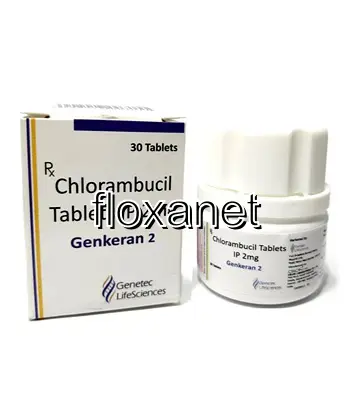| Package | Dosage | Price | Price per Dose | |
|---|---|---|---|---|
| Dosage: 2mg | ||||
| 90 pill | 2mg | $966.03 | $10.73 | |
| 60 pill | 2mg | $707.87 | $11.80 | |
| 30 pill | 2mg | $380.30 | $12.67 | |
| Dosage: 5mg | ||||
| 90 pill | 5mg | $1,360.23 | $15.12 | |
| 60 pill | 5mg | $996.57 | $16.61 | |
| 30 pill | 5mg | $549.63 | $18.32 | |

Chlorambucil Description
Overview of Chlorambucil
Chlorambucil is a chemotherapy medication that belongs to the class of alkylating agents. It is primarily used in the treatment of certain types of cancers, such as lymphomas, chronic lymphocytic leukemia (CLL), and some other lymphoproliferative disorders. This medication works by interfering with the DNA in cancer cells, which prevents their growth and division. As a result, chlorambucil helps to slow down or stop the progression of the disease. It is typically administered orally, making it more convenient for patients compared to some other chemotherapy drugs administered intravenously.
How does Chlorambucil work?
The mechanism of action of chlorambucil involves alkylation of DNA strands. By attaching an alkyl group to the DNA molecules, the drug causes cross-linking of DNA strands. This cross-linking prevents the DNA from uncoiling and replicating properly. Cancer cells, which rapidly divide, are especially vulnerable to this interruption. The damage induced by chlorambucil ultimately leads to cell death. Despite its effectiveness, normal cells can also be affected, which can lead to side effects. Due to its selective action, chlorambucil remains a valuable option in specific cancer treatment protocols.
Administration and Dosage
The medication is usually taken orally in the form of tablets. The dosage and schedule depend on the specific condition being treated, as well as the patient's overall health and response to therapy. Doctors often start with a lower dose and adjust it based on how well the patient tolerates the medication. It is critical to follow the prescribed schedule and not to alter the dose without medical guidance. Regular blood tests are generally required to monitor the patient's response and to check for potential side effects, such as blood cell counts and kidney function. Patients should inform their healthcare provider about any other medications they are taking to avoid adverse interactions.
Potential Benefits of Chlorambucil
Chlorambucil has been a mainstay in cancer treatment for many years. Its oral form offers convenience and ease of use, especially for long-term therapy. It can be effective in inducing remission and controlling disease progression in certain hematologic malignancies. When used appropriately, chlorambucil can provide symptom relief, improve quality of life, and extend survival in patients with specific types of cancer. Its role in combination therapy with other chemotherapeutic agents is also well established, often enhancing overall treatment effectiveness.
Possible Side Effects and Risks
Like many chemotherapy drugs, chlorambucil can cause a range of side effects. The most common include bone marrow suppression, leading to decreased levels of white blood cells, red blood cells, and platelets. This increases the risk of infections, anemia, and bleeding. Other side effects may include nausea, vomiting, fatigue, hair loss, and mouth sores. Some patients experience allergic reactions or skin rashes. Long-term use might increase the risk of secondary cancers, such as leukemia. Patients should be closely monitored during treatment to manage any adverse effects promptly. It is essential to report any unusual symptoms to the healthcare provider immediately.
Precautions and Considerations
Before starting chlorambucil therapy, patients should disclose their full medical history, including any existing blood disorders, liver or kidney problems, or known allergies. Pregnancy and breastfeeding are contraindications because the drug can harm the fetus or infant. Contraception is recommended for women of childbearing age during treatment. Patients should avoid live vaccines while on chlorambucil, as their immune system may be compromised. Regular medical follow-ups are paramount to ensure safe administration and to adjust dosages as necessary. Patients should also avoid exposure to infections and maintain good hygiene practices during therapy.
